Rough and tumble, and now a lot harder to access than it used to be, the Gardner is one of our favorite Yellowstone Park fisheries for fit anglers of all skill levels
The Gardner River is the closest stream besides the Yellowstone to the town of Gardiner (yes, the names are spelled differently, even if trapper Johnson Gardner is the namesake for both). Smaller than the Lamar and Madison, larger than the Gibbon and Firehole, the Gardner is a midsize mountain river in its lower reaches that offers a total mixed bag of trout (plus whitefish) and fishes exceptionally well with nymphs. With the notable exception of the fall-run brown and rainbow trout that enter from the Yellowstone, the Gardner offers few large fish, but it can turn out excellent numbers.
The Gardner has undergone a lot of change in recent years. The first change was in regards to angling and especially guided angling pressure. When I first began fishing the Gardner in 1993 it was uncommon to find more than one angler per mile anywhere on the river. Until at least 2010 it was possible to chase fall-run brown trout in the middle of the afternoon on beautiful September days without any competition. Things began changing around 2013, when upper stretches of the river began attracting 10X the guided pressure they used to, guides attracted by the easy “beginner brookie” fishing in this stretch. Starting around 2016 this pressure spilled over into the lower river. By 2020, it was necessary to be on the river half an hour before sunrise (legal fishing hours) with your favorite brown trout pool staked out. Otherwise, guides from Gardiner and beyond would beat you to it. I stopped guiding or fishing for fall-run browns prior to October in 2017 for this reason.
The second change is a lot more obvious. You probably saw it on the news or Internet in June 2022: the massive Yellowstone flood on June 13, 2022 impacted the Gardner more than any other river. It filled in most of the fall brown trout pools (they’ll clear out again, and new ones have already formed), rearranged river channels, and ate the 100-year-old North Entrance Road that used to closely parallel the Gardner in its lower reaches.
The flood and subsequent rearrangement of Yellowstone Park’s road and (likely) trail system means access to the Gardner will be very different moving forward. The formerly roadside lower river will now require a hike. This will drastically improve fishing long-term, reducing pressure and “freshening” the structure. In fact, 2023 offered exceptional fishing on the lower Gardner River, even as much of the structure remains “raw” from the flood. It seems likely the Gardner will be a better river moving forward than it has been for quite some times.
- We run many Walk & Wade Guided Trips on the Gardner: beginner trips in the headwaters, summer trips deep into Sheepeater Canyon for any anglers who want to rock-hop, and October trips on the lower river in search of BWO hatches and big pre-spawn brown trout.
- Gardner River Stream Gauge: Sudden spikes mean muddy water on the lower river, though sometimes the water is clear in Sheepeater Canyon and above. Flows under around 500cfs fish well, provided the water levels are flat or dropping.
Gardner River – Description
The Gardner River has two very distinct personalities that seem to come in reverse order.
In its upper reaches, where you’d expect a rough mountain creek, the Gardner is instead a gentle meadow creek flowing through a broad bowl-shaped valley. While there are occasional riffles and short stretches of pocket water, this is generally a very approachable stream ideal for beginners and novices, including kids provided they’re “troopers” able to hike a mile or two on fairly flat and open ground. This is a stretch of water that’s easily waded in a pair of good outdoor sandals like Tevas, or even a pair of old sneakers.
This character changes when the Gardner is first visible from a road, near Indian Creek Campground. Here the river hooks abruptly north and begins cutting down into a nasty canyon, Sheepeater Canyon. It leaps a couple named waterfalls and many more that don’t have official names, and even where the canyon walls aren’t quite vertical the going is quite difficult and there are few access points, at least access points that wouldn’t require rock climbing skills.
Sheepeater Canyon opens up a bit several miles downstream, but the valley remains steep and the river remains swift all the way to its confluence with the Yellowstone River at east side of Gardiner about 7mi further downstream. There are several small meadows in this “second personality,” both downstream of the canyon and within it, but they are aberrations. The river drops almost 2000 feet in no more than 12 miles in Sheepeater Canyon and downstream, no more than 200 of them in named waterfalls, which should give you an idea of the overall gradient.
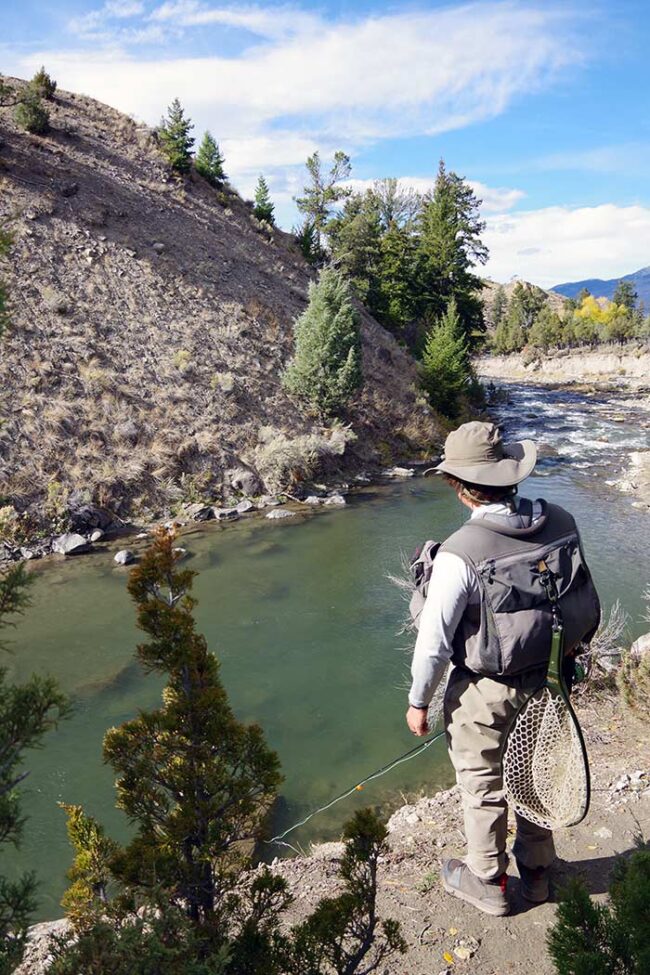
Walter eyes typical structure for the lower Gardiner: a large pool separated from the next by a long run of heavy pocket water, with steep, rocky banks throughout. This pool no longer exists.
The topography and plant life change quite a bit, too. While the upper Gardner is in lush alpine grasslands interspersed with occasional copses of cottonwoods and pines, and can be quite brushy, Sheepeater Canyon is steep and rocky, and the steep banks are often covered in dense new pine trees hiding the snags that burned during the 1988 fires.
The lower Gardner Valley is the hottest and driest part of Yellowstone Park, and is classified as high desert. Some of the short meadow areas are quite lush, with tall grass, willows, and aspen and cottonwood stands, but many areas are dusty and covered in sparse growth of grass and sage. There’s even a lot of prickly pear cactus (and some rattlesnakes) to avoid, especially on south-facing slopes and near Gardiner.
Gardner River Map & Directions
Despite being near Gardiner, access to the Gardner River is not easy. This is especially true following the flood in June 2022, which resulted in Yellowstone Park’s North Entrance Road being moved a mile away from the river to the opposite side of the first hill, rather than running right next to the river for a couple miles south of Gardiner.
Access to the lower portion of the upper Gardner is via unofficial and semi-official hiking trails. The upper section of the upper Gardner is accessible via official trails, but there’s no reason to make a hike of over 4mi one-way for hand-size brook trout.
The easiest access to this water is via a service road located about half a mile north of the Mammoth–Norris Road Bridge. Park at the obvious parking area right at the service rode turn, then walk in on the service road. The area near the Indian Creek confluence is accessible from the first overlook. The road dead-ends at a dam over the Gardner River that provides drinking water to Mammoth Hot Springs. It’s also possible to walk up a power cut that begins here to get higher upstream. Another access is possible from an unmarked pullout south of Swan Lake. An unofficial trail begins south of this pullout, climbs over the first hill, and drops into Gardner’s Hole further upstream. Local guides pioneered this access in about 2013 and it is not obvious, so carry a map and compass if you go this way.
Sheepeater Canyon, the middle Gardner River, is accessible via unofficial but obvious trails that begin at Sheepeater Picnic Area at the upstream end and on the west side of the “High Bridge” just east of Mammoth Hot Springs at the downstream end. You could also hike in via the Osprey Falls Trail in the middle, but this is a several-mile hike with a thousand feet of vertical descent and will not produce any better than hiking in from the bottom. The trail from Sheepeater Picnic Area peters out after a mile, while access from the downstream end is possible all the way to Osprey Falls if the river is low enough to cross. Note that both these accesses are very rough and rugged, especially once the obvious trails grow faint.
The lower Gardner River is accessible from the “High Bridge” east of Mammoth, by walking in from Gardiner itself, and from various official and semi-official trailheads. The X-factor with this water for right now is which of these accesses will be available. The lower Gardiner, particularly the 3mi immediately south of the town of Gardiner, was heavily damaged by the June 2022 floods. The road used to follow this entire stretch and the official Lava Creek and Boiling River Trails and semi-official “Boneyard” Trail covered the rest. It is possible all of these accesses will not be available in 2024. The High Bridge and walking in from Gardiner were available shortly after the floods and will certainly be available moving forward. The Rescue Creek Trailhead parking area was undamaged (though the footbridge on the Rescue Creek Trail was destroyed) and will probably be available as a parking area a mile or so south of Gardiner. Otherwise, we’re on a bit of a “wait and see” phase right now.
Sections of the Gardner River
Upper Gardner River
The upper Gardner River stretches from as far into the stream’s headwaters as you want to walk down to the Mammoth–Norris Road Bridge near Indian Creek Campground.
In this stretch, the Gardner is a mountain meadow stream. In some areas the stream flows in sinuous bends between undercut banks, the pools separated only by short riffles, while where it cuts between hills there is more pocket water. Upstream from the Panther Creek confluence, it averages about twenty feet wide. It’s easy to cross at the riffles, while the pools and pocket water can be deep. It gets gradually wider as you move downstream and the river picks up assorted tributary creeks, but the basic character remains the same and the river remains crossable except early in the season.
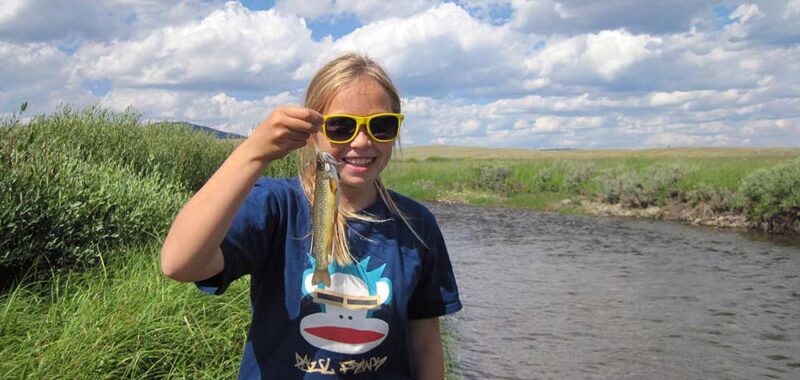
Typical angler, brook trout, and scenery on the upper Gardner River
This entire reach is populated exclusively by small brook trout. A hand-size fish is better than average. There are tons of brookies, however. Loads of small, easy fish mean this is a great beginner destination. It’s critical to shed crowds, though. This area actually sees heavy guided pressure and areas within a mile of the road are often fished out.
Sheepeater Canyon
Downstream of the bridge noted above, the Gardner picks up pace and starts cutting into a canyon. This is punctuated by its leap over Sheepeater Cascade (known in some books as Tukuarika Falls) about a mile downstream from the road bridge.
From the cascade to just past the mouth of Glen Creek, the Gardner flows through a steep-walled canyon. Numerous smaller waterfalls and heavy rapids dot the canyon, interspersed with miniature meadows between the canyon walls. There’s one more big waterfall, too, Osprey Falls at the midpoint of the canyon. Whereas trout can get past all the other falls with difficulty, Osprey is about 150 feet tall and thus a fish barrier.

One of many small waterfalls in Sheepeater Canyon. This one has no official name.
Upstream of Osprey, the Gardner remains a summer beginner fishery populated by brook and rainbow trout. Downstream, it’s a total mixed bag that can produce larger fish. In general, the largest fish are found in the bottom mile of the canyon where the river is a bit bigger, a bit slower, and a bit warmer. It’s also easier for migratory trout from the Yellowstone to reach this area than points closer to Osprey Falls.
Pressure is heavy at the very upper end of Sheepeater Canyon and again at the very bottom, but very limited in the middle. Pressure in the mile or so upstream from Osprey Falls is virtually nil. Basically, if there’s a prominent trail into the canyon, there’s probably some summer pressure. Start fishing where the trail peters out and you’ll do better.
Lower Gardner River
The Gardner emerges from Sheepeater Canyon near the mouth of Glen Creek. From here down to the Yellowstone, roughly seven miles as the crow flies, the Gardner flows primarily in a deep V-shaped valley. There are a couple short canyons, primarily one about 2mi upstream from the Yellowstone known locally as The Chutes, as well as a handful of miniature meadows. For the most part the river flows as heavy pocket water similar to lower Sheepeater Canyon. That said, the river is warmer here and produces slightly larger fish on average and much larger ones during the fall brown trout migration.
Boiling River is a major hot spring that enters at the midpoint of this section. It changes the water chemistry and temperature quite a bit, if not fishing tactics. Basically the hot spring makes for better fishing early and late in the season and heavier insect populations, but makes the water too warm from the latter half of July into mid-September except in cool summers following wet winters.
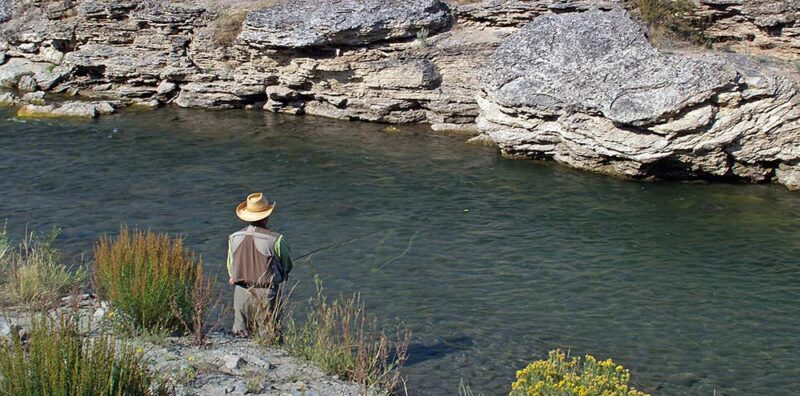
Ideal fall-run brown trout structure. This pool no longer exists, which is one reason I’m willing to show it to the Internet…
Pressure is all over the map in this section, especially with the shakeup caused by the 2022 flood. Formerly most of this water was either right next to the North Entrance Road or accessible via short (though sometimes steep) hikes on excellent official and unofficial trails. Now most of this water requires an off-trail hike to reach, and until two footbridges (on the Lava Creek and Rescue Creek trails) are replaced, stream crossings are very difficult prior to late July.
Before the floods, the heaviest pressure was in the meadows through most of the season and in the deepest pools that hold the most fall-run brown trout in the autumn. It’s safe to assume this will be the case moving forward as well, though the pressure overall will probably be lower. The stretch between the North Entrance Station and the former Boiling River Trailhead in particular should see drastically reduced angling pressure, since this former roadside section is now effectively a treacherous off-trail hike.
Angling
Fish Populations
- Rainbow Trout: are found from Sheepeater Cascade downstream. They average 6–10 inches in the upper reaches of Sheepeater Canyon and 8–12 inches from Osprey Falls downstream. A few much larger rainbows remain in the lower river in June after their spring spawn, while erratic pulses of migratory rainbows enter in October, either following brown trout on their spawning runs to eat their eggs or running early for their own spawn. Very occasionally these larger migratory rainbows reach 24 inches.
- Brown Trout: are found downstream of Osprey Falls and make up the majority of the fish population downstream of Boiling River. Resident browns average 8–12 inches. Fall-migrant browns from the Yellowstone River average 14–18 inches but occasionally get much larger. Anything over 22 inches is a trophy.
- Brook Trout: Brookies are the only fish from the headwaters down almost to Sheepeater Cascade (a few rainbows sometimes manage to climb this waterfall, but not enough to establish a population). Brookies thin out through Sheepeater Canyon and are rare in the lower Gardner. They average 4–9 inches.
- Cutthroat Trout and Rainbow/Cutthroat Hybrids: Yellowstone cutthroat are the native fish from Osprey Falls downstream to the Gardner’s mouth. They are not common. It’s not unusual for a 20-fish day to include only one cuttbow and no pure cutthroats. The cutts and cuttbows do run solid, however. They average 12–16 inches and occasionally exceed 20 inches. These fish are probably migrants from the Yellowstone that spawn in tributaries Lava and Glen Creek.
- Whitefish: Whitefish are found downstream of Osprey Falls, especially in the deep pools. They run large, 12–18 inches on average. There’s a fair chance there’s a world record whitefish somewhere in the Gardner River.
- Suckers: A few large suckers live full-time in the Gardner, but the June spawning run brings many more into the bottom 2mi of the Gardner. These fish often exceed 20 inches and seldom take flies. If you see a lot of big dark fish over shallow gravel on the lower Gardner in June, move upstream. The suckers push the trout out of the good holding water during their spawn, which makes for very difficult fishing.
Gardner River Fishing Season – When It’s Open & When It’s Good
The Gardner River is the only one in Yellowstone Park that is often fishable on the first day of the season, the dead middle of the season, and on the last day of the season, and it can often produce very well at all three times. Some portions fish better than others at certain times, however.
The upper Gardner is strictly a summer fishery. It comes into play in the first or second week of July assuming near-normal winter and spring weather. The next month is the best time for this “beginner brookie” water. It then falls off quickly through the latter part of August, so that by September 1 you’d swear there aren’t any fish. They’re all just miles into the backcountry spawning. Unless you want to hike 5mi for 7-inch brook trout, the fishing is done by about August 20.
Sheepeater Canyon comes into play a week or two before the upper Gardner due to its rocky structure, which creates fishable structure at a higher water level than the meadows upstream. The upper portion of the canyon above Osprey Falls is best in July and early August, but can produce on warm afternoons until mid-September. The lower canyon, with its more diverse fish populations, lower elevation, and chance for fall-run browns, is best in July and August but can fish well in the afternoons until mid-October.
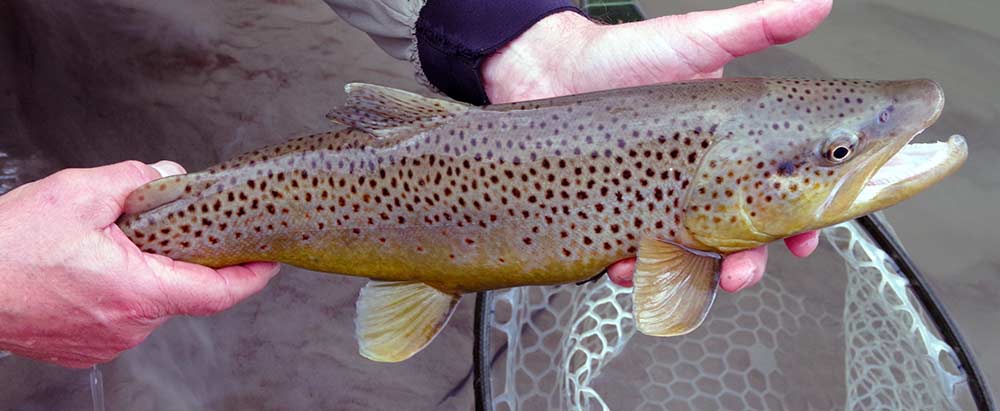
Typical Gardner River fall-run brown trout
The Lower Gardner has something of a split season due to the influence of Boiling River. From the mouth of Sheepeater Canyon to Boiling River, the river may be clear on the opener but is usually too cold. It comes into play in the last ten days of June most years and fishes best in July, is okay but not exceptional in August, then is prime again in September. Fishing continues on warmer days through the close of the park season.
From Boiling River to the confluence with the Yellowstone, the river is warm and often just clear enough to fish about three days a week from the beginning of the season until late June. You only need a foot of visibility to fish here in early June. When it’s clear enough, this early season fishing can be extremely productive, though it’s physically difficult due to fast water and tough wading. The fishing gets more consistent in the latter half of June as runoff recedes and remains strong until July 20. Warm water then limits the fishing to mornings except in cool summers until mid-September. The fishing then gets better and better until early October, then stays excellent until the close of the season. This is where I personally fish on the last day of the Yellowstone Park season every year.
Gardner River Fishing Tactics
The upper Gardner and upper Sheepeater Canyon (areas populated by brook trout) require simple tactics. Fish a #12–14 attractor dry fly or hopper of your choice with a #16–18 beadhead nymph of your choice on a dropper. That’s it. I have never done anything else either fishing or guiding here. If this tactic isn’t productive, move to a different spot. This area gets hit hard by local guides (including me) instructing beginners, so it’s often necessary to walk a couple miles or fish the roughest areas of the upper canyon to get on water that hasn’t been fished for a couple days.
Lower Sheepeater Canyon and the lower Gardner are a bit more complicated. The one constant is fishing a pair of heavy nymphs at short range, whether you’re doing this under an indicator or Euro-style. Euro or tight-line nymphing is usually more effective, given the Gardner’s preponderance of pocket water. In the pools, the indicator may have the edge. Except in its headwaters, the Gardner is a nymph river, and nymphs are most likely to produce the vast majority of your trout except during intense hatches.

Longtime Gardiner resident, former guide, and not-well-enough-known fly tier Matt Minch’s Bead, Hare, and Copper is emblematic of good nymphs for the Gardner River: simple, heavy, and suggestive of many food sources.
By the last week of June or first week of July (a week earlier in drought years), the Salmonfly and Golden Stonefly hatches begin in the lower river. They march upstream as far as Osprey Falls, but don’t get past the falls in fishable numbers. This is a long-lasting hatch on the Gardner due to Boiling River. It’s not uncommon to fish Salmonfly imitations downstream of Boiling River on June 25 downstream of Boiling River and on July 25 in lower Sheepeater Canyon. While standby foam patterns can work, don’t hesitate to use traditional “fur and feather” Salmonflies like Improved Sofa Pillows and Orange Stimulators. When these start to sink, let them. The Gardner is rough enough that most stoneflies drown when they hit the water, and these bugs make easy prey for trout.
July and early August also see fair dry-dropper fishing. Basically if the fish haven’t been getting hit hard, they’ll eat some sort of attractor dry-dropper combo in the pocket water. If they have been getting hit hard, they might only take the nymph and your big fluffy dry is little more than a strike indicator. The farther you get from easy accesses such as the High Bridge near Mammoth, the better the dry fly bite.
Daytime hatches of small insects seldom need to be matched on the Gardner in summer, but occasional evening caddis hatches can bring good fishing. Fish a big Trude or Clacka Caddis with an imitative caddis on the dropper.
August and early September see decent hopper activity. The best hopper bite is on the lower Gardner during cool summers. Walk through the dry grass and sagebrush lining the river at this time and you’ll see why. As with attractor dry-dropper fishing, the hopper bite depends a lot on angling pressure. Lots of pressure means a poor hopper bite.
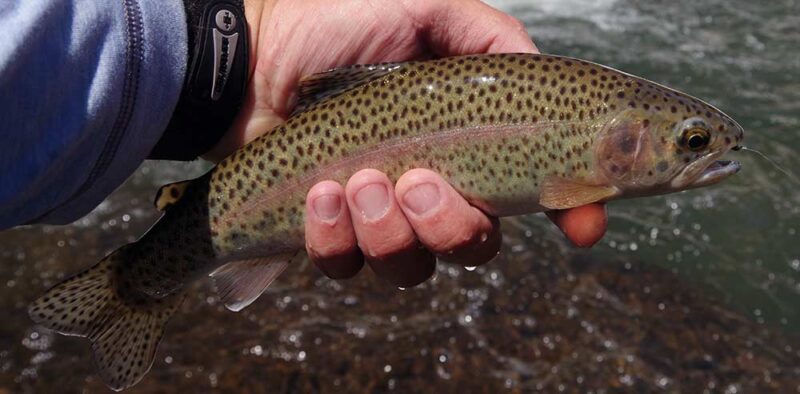
Typical Gardner River rainbow trout
In September, mayfly hatches intensify. There are some Tan Drakes, particularly upstream from Boiling River, but Blue-winged Olives are far more important. Hatches happen first above Boiling River, then below. The best hatches below Boiling River occur in the latter half of October. These hatches are often very localized. One pool will have 15 rainbows and a couple fall-run browns rising, while the next won’t have any rising fish. I usually carry a Tenkara rod pre-rigged with a BWO (usually my Purple Hazy Cripple or an Upbeat Baetis) so that I can put down my nymph rod and switch easily to dries when I encounter a hatch.
A moment ago I mentioned fall-run browns. After Labor Day, these become the focus for most anglers. In September, this is strictly a morning show. Fish from dawn until the sunlight gets full on the water. Fish stonefly and large attractor nymphs or eggs in the big pools from the lower end of Sheepeater Canyon down. Most of the time local guides will beat you to the best areas, or at least they did prior to the 2022 floods which have upended the Gardner a bit. I used to guide here all the time in September, but stopped in 2017 due to rapidly increasing crowds.
The crowds decline and the fish spread out in October. The pools are still the best bets, but particularly during ugly weather you can also find fair numbers of big browns in the deepest, heaviest pocket water. I assume these fish are migrating towards spawning areas in enough numbers it’s possible to “intercept” them. Some big rainbows also join the party in October and usually eat egg patterns.
The brown trout spawn begins between October 15 and October 20. After the trout start spawning, avoid fishing or wading shallow areas. The spawn is spread out enough in terms of timing that there are always enough fish in the deeper pools and heavy pocket water, fish that either haven’t started spawning yet or have already finished. The fishing for resident trout just gets better and better in late October, too, as these fish feed on nymphs disturbed by spawning activity, BWO, and especially on eggs.
Insect Hatches & Other Prey
Insect hatches are usually of limited importance on the Gardner. You’ll see some bugs flying around, but most of the time you need only match their approximate size and silhouette. Use a Hazy Cripple to match mayflies, a Chubby Chernobyl to match stoneflies, and a Coachman Trude to match caddisflies, for example.
That said, the July stonefly hatches can bring excellent fishing on the Gardner, there are occasional excellent Tan Caddis hatches on summer evenings right before sunset, and the fall Blue-winged Olive hatches can produce great dry fly fishing in the afternoons, even if they are spotty.
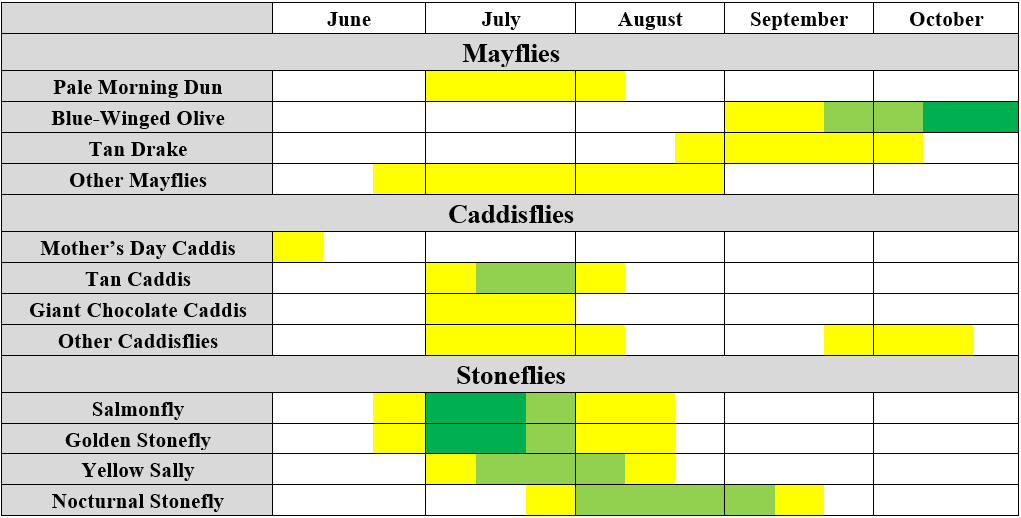
Other flies that work well on the Gardner River center on attractor nymphs and to a lesser extent on robust attractor dry flies, big ones like Chubby Chernobyls on the lower Gardner and smaller ones like Trudes, Clacka Caddis, and Wulffs in the brook trout water in the headwaters.
Attractor nymphs should imitate a variety of food items. Flies like Girdle Bugs, Princes, and Matt Minch’s Bead, Hare, and Copper (developed for this river, by a Gardiner resident) usually work far better than flies suggesting only one type of food. Even when you fish a fly suggestive of only one type of aquatic food item—mayflies, for example—it’s usually best to opt for something flashy like a Lightning Bug, rather than something drab like a Pheasant Tail.
One note: except in its meadow-stream headwaters, the Gardner River is ideally-suited to Euro-nymphing, particularly Czech-style nymphing with heavy flies and very little line. Anglers skilled in or eager to learn this tactic are advised to fish the heavy pocket water on the Gardner.
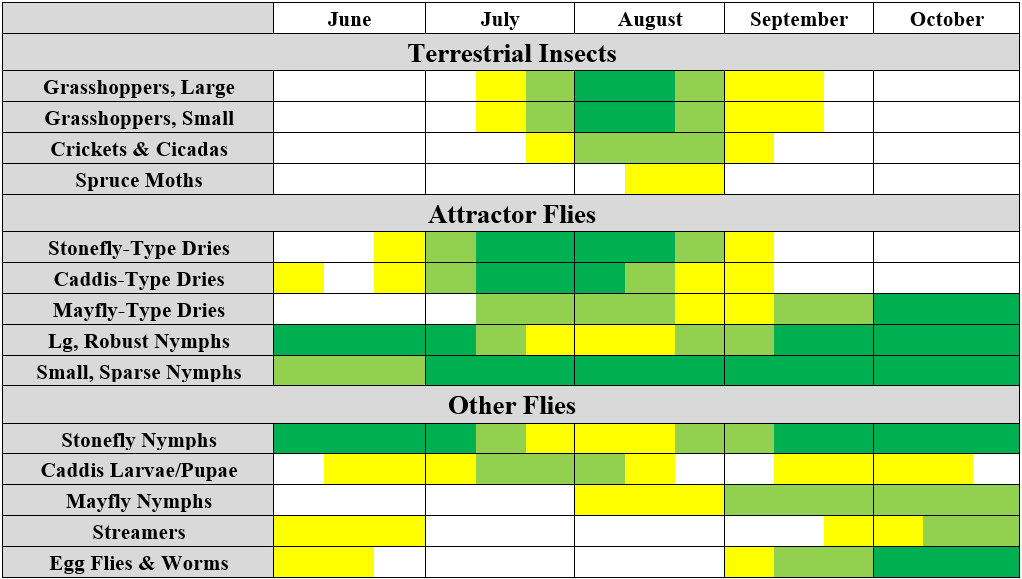
Top 10 Flies for the Gardner River
- Minch’s Bead, Hare, and Copper, #12–16
- Minch’s Golden Stone, #8–12
- Gold Chubby Chernobyl, #10
- Tunghead 20-Incher, #10–12
- Pink Egg Fly, #16
- Tan/Black TJ Hooker, #10
- Brown Girdle Bug, #6
- Purple Hazy Cripple, #16–18
- Coachman Trude, #12–14
- Beadhead Prince, #16–18